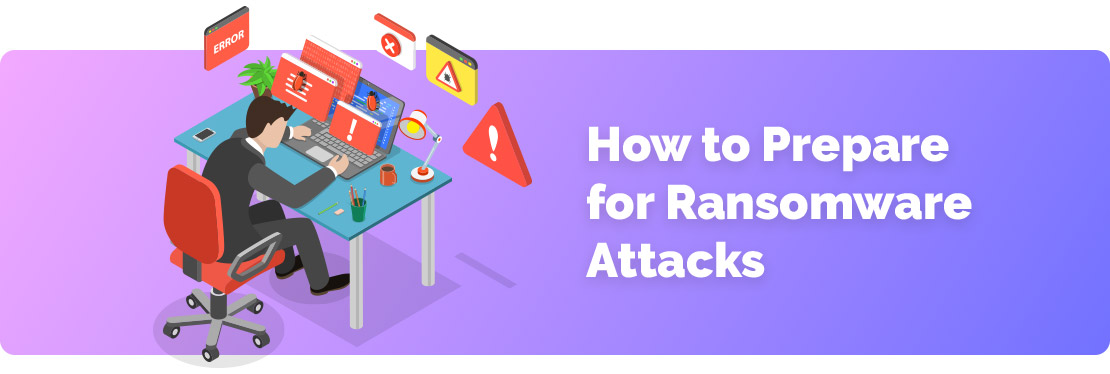Sep 6, 2023

A ransomware attack is a malicious act where cyber criminals encrypt sensitive data on a victim's computer network. Ransomware is a type of malware that renders the data out of reach. They make a ransom demand, asking you to pay the ransom in exchange for providing the decryption key.
Such attacks can cripple a business by disrupting operations. This can cause financial losses, tarnish a reputation, compromise customer data, and lead to regulatory penalties.
Cybersecurity analysts witnessed a significant surge in ransomware attacks recently, marking March as the most active month in recent history. With a staggering 459 recorded attacks, there was a striking 91% rise compared to the previous month. There was also a substantial 62% increase compared to March 2022.
These statistics are the reason that cybersecurity should be included in the risk management strategy for all business owners. Adequate preparation is essential to mitigate the devastating consequences of ransomware infection in 2023.
Read on to learn more about what to be on the lookout for and how to prepare for a ransomware attack from the experts at Blade Technologies.
Stay Protected with Blade
Looking for Ransomware protection in St. Louis? Contact the experts at Blade today.
Request Service
Types of Ransomware
Understanding the different types of ransomware can help individuals and businesses enhance their preparedness. In addition, adopting appropriate security measures can mitigate the risks associated with each variant.
Encrypting Ransomware
This is the most common type of ransomware. It encrypts files and data on the victim's system, making them inaccessible until a ransom is paid.
Locker Ransomware
Locker ransomware locks users out of their devices, denying access to the system entirely. It typically displays a full-screen message with instructions for payment.
Master Boot Record (MBR) Ransomware
This type of ransomware infects the Master Boot Record, preventing the system from booting. It displays a ransom message before the operating system loads.
Mobile Ransomware
Mobile ransomware targets mobile devices, typically through malicious apps or infected links. It can lock the device, encrypt files, or steal personal information.
Scareware
Scareware uses scare tactics to deceive and intimidate victims of ransomware. It displays alarming pop-up messages, which claim that the device is infected with malware. It then urges ransom payments for removal.
Transitioning Back to the Office
Blade Technologies has made a noteworthy observation regarding ransomware attacks and remote work. As small-to-medium-sized businesses transition back to the office, instances of ransomware attacks decrease. This finding suggests that the physical presence and enhanced security measures within office environments serve as a deterrent to cyber criminals.
This highlights the importance of a secure work environment in mitigating the risk of such attacks.
How to Properly Prepare for an Attack
Small and medium-sized businesses may have an inherent advantage when it comes to ransomware attacks. However, it is still essential to be prepared. The experts at Blade have identified several tips to avoid being an easy target. Prevention and preparedness are key to safeguarding valuable data and maintaining business continuity.
Implement Robust Cybersecurity Measures
- Install and regularly update reliable antivirus and anti-malware software on all devices.
- Enable automatic software updates for operating systems and applications to patch vulnerabilities.
- Use strong, unique passwords for all accounts. Consider implementing multi-factor authentication (MFA) for added security and avoid remote desktop protocols.
- Regularly back up important data and store it offline or in a secure, cloud-based backup solution.
Educate and Train Employees
- Conduct regular cybersecurity awareness training sessions to educate employees about phishing emails, suspicious links, and other common attack vectors.
- Encourage employees to exercise caution while opening attachments or clicking on unfamiliar links, even if they appear legitimate.
- Establish a clear reporting process for suspicious activities or potential security breaches.
Develop an Incident Response Plan
- Create a comprehensive incident response plan that outlines the steps to be taken in the event of a ransomware attack. This can include contacting appropriate law enforcement agencies, company communication, and data recovery measures.
- Designate specific individuals responsible for different aspects of the response plan, including communication, data recovery, and legal considerations.
- Regularly test and update the incident response plan to ensure its effectiveness and alignment with evolving threats.
Partner with Blade to Prevent Ransomware Attacks
For almost two decades, Blade has established itself as the premier Cybersecurity company in St. Louis. Our highly skilled IT experts collaborate closely with you to identify the specific IT support systems your business needs.
At Blade, our mission is to protect against ransomware attacks and reduce any downtime your business may experience as a result of a breach. This is done by assisting organizations in minimizing financial losses, safeguarding critical data, and ensuring uninterrupted business operations.
Contact Blade in St. Louis today to request service.
Contact Us